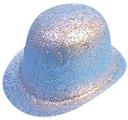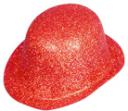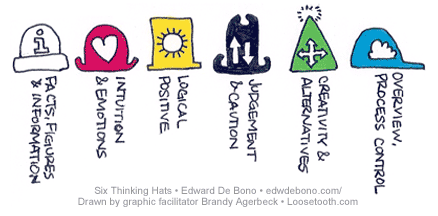Sorry, but this is a long one …….
I thought I would use De Bono’s Thinking Hats to organise my thinking and reflecting on using Samorost as an aid to teaching Narrative with my Year 4, 5 and 6 students.
 White hat: Just the facts…..
White hat: Just the facts…..
- Curriculum Link: narrative writing in English
- Class had already discussed
- structure
- purpose
- problem/complication
- characters
- language of narratives
- First experience with game = played the game together as a class and wrote down our first impressions of the game.
- Talked about Intro scene (45 minute session) –
- Discussed purpose of this scene and linked it to a narrative
- Students shared words and phrases that could describe the little planet. Tried to set the atmosphere of the story – calm, peaceful, mysterious
- Played around with interesting language, shared vocab, wrote sentences using shared vocab (kids scribbled in notebooks), and rearranged these sentences to see what would happen (were they better, worse, more/less effective?)
- Played Samorost 2
- Collaboratively brainstormed (in three’s) words to make a “Feelings” matrix of words and phrases to use that would show rather than tell how a character is feeling or the mood in a scene.
- Discussed similes, metaphors and imagery as ways of adding to descriptions. Found examples in literature that used similes, metaphors and imagery. (We collect great sentences or phrases, type them up and put them on the wall for language/literature activities)
- Explored the Anteater scene (1 hour session) –
- Imagined what it would look, feel, sound like in the metal ball that descended into the anteater scene of Samorost 1. Closed our eyes and imagined.
- Thought of ways that Sammi would move that would indicate how he was feeling. Actually acted out ways he might exit the ball and how they would show how he was feeling.
- Tried to “step back” from the scene and look at the environment to identify any images that we could use.
- The kids were writing down any interesting ideas, phrases, words, sentences that they came up with as we went along
- Time for writing throughout the session – jotting as well as constructing
- Sharing each student’s “best bits”
 Red Hat: Feelings and emotions …..
Red Hat: Feelings and emotions …..
- Successful because it was embedded into the curriculum – it was an integral part of what we were doing – not added on because it was a game.
- High engagement with the game transferred to the writing about the various scenes. It was almost as if the kids felt they were part of the game/world and so it was motivating and just an extension of the game to write down what happened.
- Group situation supported all students in taking risks in using unfamiliar language, looking for and using imagery, and experimenting with sentence structure and order.
 Black hat: Negatives and cautions ….
Black hat: Negatives and cautions ….
- Students may not have the language experiences to adequately describe what they see or feel.
- Scaffolding that is needed by the teacher could shift the focus from the student back to the teacher (who takes over).
- Issues with the pipe smoking
 Yellow Hat: Positives and optimism …..
Yellow Hat: Positives and optimism …..
- Enabled the students to become part of the story they were writing
- They had acted out the story by playing the game, they had been in the setting and knew ( or even were) the main character
- Going through various scenes again enabled the students to talk about what they could see, put words to their emotions and to use these words to build pictures about the scenes
- Shown how to write with emotion – closed their eyes and felt what it would be like
- Used their senses to get a deeper feeling for the setting and for their character
- Using the game meant that all the students had a common experience to work from. The virtual experience meant that everyone was able to share thoughts on a variety of surreal environments.
- Students who find it too difficult to write (special needs) drew beautiful and very detailed drawings of the environments we were looking at. Able to add the action that thought would happen.
- Early ESL learner wrote one sentence (with difficulty) on the first day, three sentences on the second day and half a page in the third session.
 Green Hat: Creative ideas and alternatives …..
Green Hat: Creative ideas and alternatives …..
- Students could collage new scenes or environments that might be a part of Samorost 3
- Use the camera to take photos around the school of interesting nooks and crannies that could then be photo-shopped to create digital collages of new scenes/environments.
- Students could write about what happens to Sammi and his dog at the end of Samorost 2
- Map the planets
- Tell the story from the point of view of another character (Samorost 2)
- Write procedure for making pear juice (Samorost 2)
- Write up “walk throughs” for other groups
- Use Mission Maker to make their own game
- Colin Thompson books set in tiny worlds
 Blue Hat: Thinking about the thinking ….
Blue Hat: Thinking about the thinking ….
- Whole class group sessions were vitally important as the more able students were able to model and share confidently, and the other students used this modeling to join in and contribute
- The idea of being in the game/story was the big difference. The structures were already there, in the game/story – the students were free to describe what they saw and felt without having to control all the other aspects of a narrative (the complication and resolution, the climax and ending).
- Because the game was purely visual, this allowed the students the freedom to add any text they liked:
- Conversational spoken texts as they played the game
- Logical procedural spoken texts as they problem solved whilst playing
- Basic field building vocab in first impressions writing
- Leading to figurative language building in consequent written texts
- The students grabbed hold of this opportunity to experiment with language in a non-threatening environment, where they were scaffolded by the story to play around with ideas for using language. It put the students at the centre of control of the language being used.

Hello there
I also did a post on “Thinking About Samorost”.
Come and check it ou. I think your one is better than mines, even through it’s very long.
Celia 🙂
Thanks Celia, you are very kind 🙂
Your post shows that you thought very carefully about Samorost – thank you.
PS – sorry it was such a long post – you know I like to talk a lot 😀
As an aside… where did you buy the thinking hats that are on your classroom wall?
Rich
My sparkly thinking hats were bought in the party section of my local supermarket. They are really light plastic, but I couldn’y resist the sparkles for a touch of the ol’ razzle dazzle 😆
A colleague used “trucker caps” (ordinary caps with a visor at the front), and how about wild and wacky ones from an op shop?
KimP